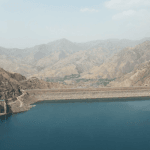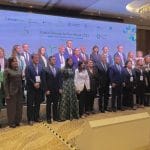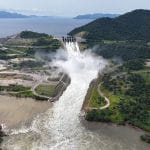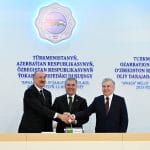Nord Stream 2 AG, which is constructing a controversial gas pipeline from Russia to Germany, is looking for solutions to complete the pipelaying of the offshore section in the Danish territorial waters that was halted after the US sanctions, the company told New Europe on 26 February.
“A total of 2,300 kilometres out of approximately 2,460 kilometres, or 94% of the Nord Stream 2 Pipeline had been laid by 20 December 2019, when our contractor Allseas was forced to suspend the pipelay in anticipation of the enactment of the US National Defense Authorization Act (NDAA). We are actively looking for solutions and will inform about it in due time,” Nord Stream 2 said, adding that all other works like the completion of landfalls and offshore works for stabilising the pipeline continue as planned.
After getting the much-delayed permit to construct the Nord Stream 2 pipeline in Danish territorial waters, the combined speed of laying of the two vessels from Swiss company Allseas Group SA amounted to approximately 8 kilometres per day. It would have taken several weeks to complete pipelay but the US sanctions forced Allseas to abandon work on the pipeline at the end of December. The project was expected to be completed by the end of 2019 but now there is no timeline now when the pipeline will be finished.
The United States has opposed Nord Stream 2, saying it would increase Europe’s gas reliance on Russia. Instead, US President Donald J. Trump has proposed that Europe buys liquefied natural gas (LNG) cargoes from the US.
Katja Yafimava, a senior research fellow at the Oxford Institute for Energy Studies, told New Europe on 25 February it is beyond doubt that Nord Stream 2 will be completed. “I understand there are different options – it could be the Fortuna vessel which is already in the Baltic Sea, or Akademik Cherskiy, which has left Nakhodka, has already passed Singapore, and at present is heading towards Sri Lanka. If it is going to the Baltic Sea it would take it approximately 1.5-2 months to arrive there,” she said, explaining that Akademik Cherskiy belongs to Russian gas monopoly Gazprom’s subsidiary, Gazprom Flot, and has done various offshore works in the past which suggests that it has the expertise and could finish the construction of Nord Stream 2, particularly as the remaining section is not very deep water.
Fortuna, which belongs to the Russian company MRTS, also could do it but, unlike Akademik Cherskiy, it does not have a dynamic positioning capability, Yafimava said. “My reading of the Danish permit is such that although it was granted on the assumption that a vessel with the dynamic positioning capability would be used, it appears to allow for a vessel without a dynamic positioning capability to be used should the Danish Energy Agency and Nord Stream 2 agree,” she added.
On 25 July 25 2019, Nord Stream 2 brought an action for annulment before the General Court of the Court of Justice of the EU. The annulment would lead to the cancellation of the amendment to the Gas Directive “as the amendment was clearly designed and adopted for the purpose of illegitimately disadvantaging Nord Stream 2,” the company told New Europe on 26 February. “The conclusions of leading legal experts support our argumentation,” Nord Stream 2 argued.
The company also served a notice of arbitration to the EU on 26 September 2019 based on the provisions of the Energy Charta Treaty (ECT) for investor protection. “The amended Gas Directive breaches the EU’s obligation from the ECT not to take such discriminatory action, and it is also in breach of the EU’s obligation to create fair and equitable treatment,” Nord Stream 2 argued.
Asked about Nord Stream-2 launching a legal action against the European Commission in CJEU requesting to annul the amendment to the Third Gas Directive, as well as arbitration under the Energy Charter Treaty provisions on investment protection and promotion, Yafimava told New Europe that her interpretation is that in launching those actions Nord Stream 2 is trying to preserve the legal/regulatory regime that was applicable to it at the time of making an investment, and which has changed to the worse with the adoption of the Third Gas Directive amendment, which has subjected the German section of Nord Stream-2 to its provisions on Third Party Access, tariffs and unbundling.
follow on twitter @energyinsider







